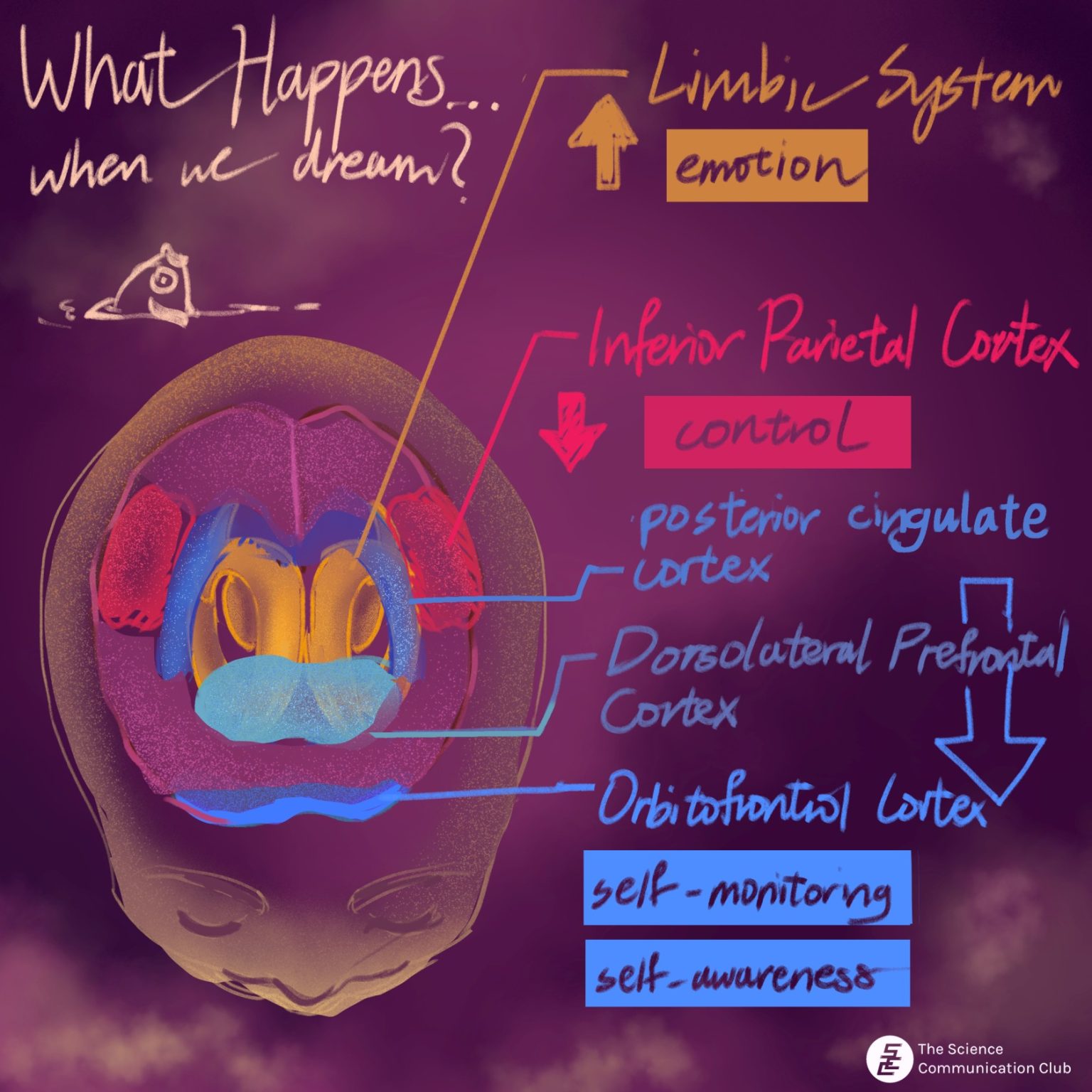
Written by Catherine Ma
Illustrated by Yuki Lee
You are sitting at your childhood dining table, eating pink-and-yellow striped Goldfish crackers. Your little brother is sitting next to you, and he presents you with seven new Goldfish cracker flavours. “They’re all named after Pokemon,” he says. Right—Pokemon are real now. They’ve been in the news all day and you’re trying to adopt one. You wanted Bulbasoar but you keep getting MagiKarp. There are three MagiKarp across from you. They’re different colours. Why? One’s sick. It’s allergic to Goldfish crackers. It’s going to die. Oh God—you’re going to be arrested by PETA. This is bad. Their van is here already. You clutch your brothers in your arms and tell him you love him. He screams as the masked PETA officers break down the door.
You wake up trembling, palms sweaty, pulse racing, in the darkness of your bedroom. You think: Wow, what a weird dream. Then, if you are like the majority of people, you forget it within minutes and go about your daily life.
But say you pause for a moment after that first thought and wonder, Why did I have that dream? And furthermore: What even are dreams?
Theories of Dreaming
Up until recently, dreams were largely unexplored from a scientific perspective. Societies the world over have come up with their own theories of dreams, from believing that they’re a form of communication between greater deities and us mere mortals to considering them prophetic visions.1
It was only in the 20th century that, with the advent of psychology as a discipline, researchers decided to study dreams. There’s the classic Freudian concept of dreams as manifestations of unconscious desires and traumas (and, because it’s Freud, sex) 2, which, while generally discredited, does make some pertinent points, such as the fact that trauma can affect the content of dreams, as in disorders such as PTSD 3 and in cases such as childhood neglect 4. Then there’s the activation synthesis theory, which takes the direct opposite stance to Freud, suggesting that dreams are the “junk” byproduct of our brains interpreting random patterns of activation during sleep. This too has been criticized as being inaccurate and incomplete 5. The comparatively more recent threat simulation theory suggests that dreams may be an evolutionary adaptation meant to help humans and other animals consider and plan for threats 6, which I guess in our modern age include forgetting to study for an exam and not wearing pants to work.
Current research suggests an overlap between dreaming and memory processes. When we’re dreaming, we activate certain parts of our brain in similar ways to how they are active when we recall memories; for example, researchers found that, in both cases, individuals exhibit low-frequency brain waves (brain waves just describe an electrical measure of brain activity using electrodes) 7 in their frontal lobes, which are involved in memory processes, movement, and self-regulation 8. Additionally, people tend to more accurately recall memories of an event if they dream about it afterwards 9. All the more reason to make sure you get some sleep after studying at night!

Brain Activation During Dreams
There are a few phases of sleep characterized by different kinds of brain activity, but for now the important distinctions are between Rapid Eye Movement (REM) sleep and the other stages, which can be categorized as Non-Rapid Eye Movement (NREM) sleep. During REM sleep (which, unsurprisingly, involves increased eye movements as well as increased heart rate and blood pressure), dreams are most common and most vivid 10.
NREM dreams, at least at the start of the night, tend to be “flatter” than those during REM sleep, and involve less emotion. They are shorter, more fragmentary, and more realistic than REM dreams. For example, an NREM dream occurring earlier in the night might involve noticing a confusing new assignment released by a professor. Contrast that to REM and late-night NREM dreams, which tend to be the wild, emotional, narrative-driven dreams where you’re starting a rock band with Taylor Swift and your calculus professor 10.
Dreaming involves the activation of brain areas associated with our senses. For example, more vivid imagery during dreaming is associated with increased activity in parts of the occipito-temporal visual cortex, an area involved in visual processing 8. Interestingly, other parts of the brain which are highly important for sensory perception are less active when we sleep. The most notable of these is the thalamus, which acts as a “relay station” for sensory signals coming into the brain for all senses except for smell 8. This might explain why we are less aware of our environment while asleep, aka why our friends at the sleepover can get away with drawing a moustache on our face.
Beyond that, there’s increased activation of many brain areas associated with emotion, such as structures in the limbic and paralimbic systems, both of which are implicated in emotion processing. These include the amygdala 8, a small, almond-shaped structure best associated with emotion processing, most notably of fear and aggression 11. That might be why we tend to feel extreme emotions during dreams, with terror being a common example.
What about our lack of control within dreams? That could be because our right inferior parietal cortex, an area involved in free will while we’re awake, tends to be less active when we sleep 8.
As for why our dreams are so damn weird? There’s a similar reduction in activity in areas related to self-monitoring and self-awareness, such as the posterior cingulate cortex, inferior parietal cortex, orbitofrontal cortex, and the dorsolateral prefrontal cortex. That’s why we can do things we would never consider when awake, such as fist-fighting our boss or running for prime minister, as well as accept inconsistent scene switches and impossible events 8.
Wait, That’s It?
Yes, seriously. That’s all there is to know.
Sike! (More like “psych”, am I right?)
There is so much more that I could cover on this topic. How do recurring dreams work? Why are some dreams common among different individuals? Most importantly, what goes into creating the storylines of our dreams, with their fascinating mishmash of memories and anxieties, along with what I can only scientifically describe as truly whack events?
The truth is that we still don’t have a lot of the answers to dreams 11. Hopefully new research will shine a light on this underexplored area, but until then, we’re unfortunately stuck in the dark.
So take heart, brave explorer, next time you close your eyes to sleep. You’re about to venture into a mind-boggling and mysterious simulation all thanks to the squishy conglomeration of neurons and glia that is your brain and nervous system. Have fun saving the world and make sure to check that you’re wearing pants before heading out to the exam! You’ve got this.
Sources:
1. Gibney E. Game-playing software holds lessons for neuroscience. Nature. 2015;518(7540):465–466. doi:10.1038/518465a
2. AI Engines for Pong. [accessed 2023 Nov 10]. https://www.cs.toronto.edu/~guerzhoy/niftypong/
3. Kagan BJ, Kitchen AC, Tran NT, Habibollahi F, Khajehnejad M, Parker BJ, Bhat A, Rollo B, Razi A, Friston KJ. In vitro neurons learn and exhibit sentience when embodied in a simulated game-world. Neuron. 2022;110(23):3952-3969.e8. doi:10.1016/j.neuron.2022.09.001
4. Ledford H. Neurons in a dish learn to play Pong — what’s next? Nature. 2022;610(7932):433–433. doi:10.1038/d41586-022-03229-y
5. Smirnova L, Caffo BS, Gracias DH, Huang Q, Morales Pantoja IE, Tang B, Zack DJ, Berlinicke CA, Boyd JL, Harris TD, et al. Organoid intelligence (OI): the new frontier in biocomputing and intelligence-in-a-dish. Frontiers in Science. 2023 [accessed 2023 Nov 10];0. https://www.frontiersin.org/journals/science/articles/10.3389/fsci.2023.1017235/full. doi:10.3389/fsci.2023.1017235
6. Jensen C, Teng Y. Is It Time to Start Transitioning From 2D to 3D Cell Culture? Frontiers in Molecular Biosciences. 2020 [accessed 2023 Nov 10];7. https://www.frontiersin.org/articles/10.3389/fmolb.2020.00033
7. Sato T, Vries RG, Snippert HJ, van de Wetering M, Barker N, Stange DE, van Es JH, Abo A, Kujala P, Peters PJ, et al. Single Lgr5 stem cells build crypt-villus structures in vitro without a mesenchymal niche. Nature. 2009;459(7244):262–265. doi:10.1038/nature07935
8. Thomas Hartung and colleagues | The future of organoid intelligence | Frontiers Forum Deep Dive 2023. 2023. https://www.youtube.com/watch?v=3dIjWDCchtc